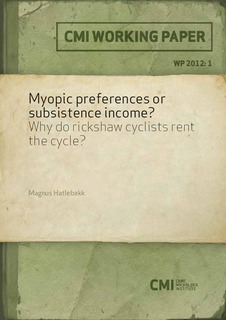| dc.contributor.author | Hatlebakk, Magnus | |
| dc.date.accessioned | 2018-01-04T08:18:46Z | |
| dc.date.available | 2018-01-04T08:18:46Z | |
| dc.date.issued | 2012-01-27 | |
| dc.identifier | oai:www.cmi.no:4368 | |
| dc.identifier.citation | Bergen: Chr. Michelsen Institute (CMI Working Paper WP 2012:1) 15 p. | |
| dc.identifier.isbn | 978-82-8062-426-0 | |
| dc.identifier.issn | 0804-3639 | |
| dc.identifier.uri | http://hdl.handle.net/11250/2474911 | |
| dc.description.abstract | One year rent is sufficient to buy a rickshaw in the plains of Nepal, while a rickshaw will last many years, so purchase appears very profitable. Still most cyclists rent the rickshaw. Based on choices made by rickshaw pullers between hypothetical financing schemes for rickshaws we investigate whether the explanation is a high time-preference rate or a high elasticity of the marginal utility of consumption, which in turn can be explained by preferences that are formed by consumption near a subsistence level. We find that subsistence constraints are more important than myopic preferences. | |
| dc.language.iso | eng | |
| dc.publisher | Chr. Michelsen Institute | |
| dc.relation | CMI Working Paper | |
| dc.relation | WP 2012:1 | |
| dc.relation.ispartof | CMI Working Paper | |
| dc.relation.ispartofseries | CMI Working Paper WP 2012:1 | |
| dc.relation.uri | https://www.cmi.no/publications/4368-myopic-preferences-or-subsistence-income | |
| dc.subject | Investment Behavior | |
| dc.subject | Poverty | |
| dc.subject | Time-Preferences | |
| dc.subject | Nepal | |
| dc.title | Myopic preferences or subsistence income? Why do rickshaw cyclists rent the cycle? | |
| dc.type | Working paper | |
